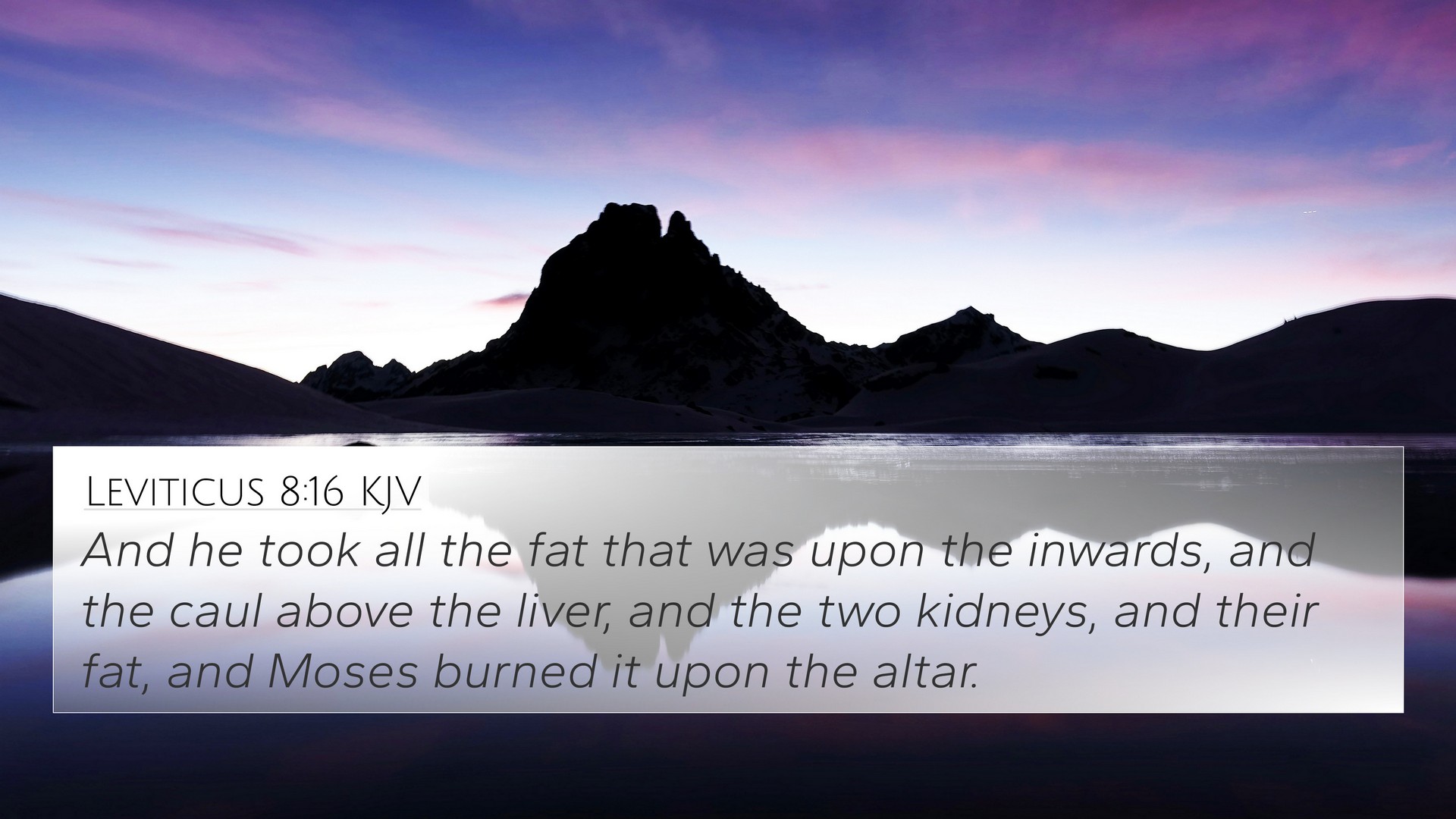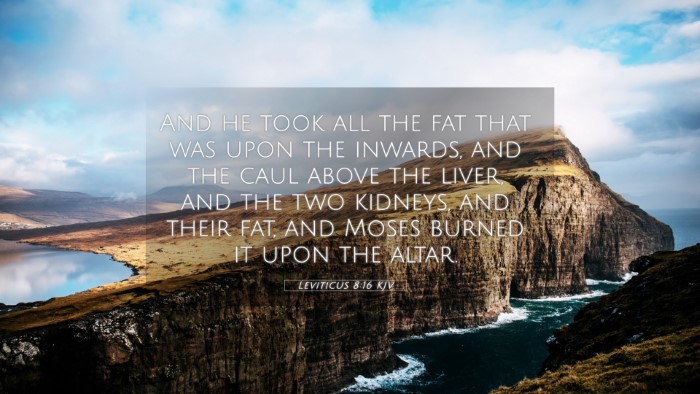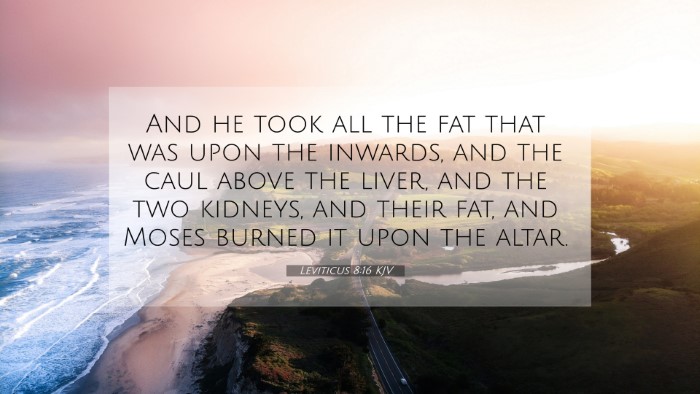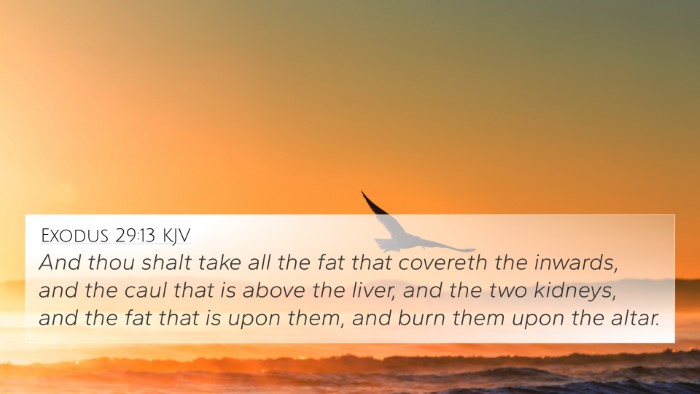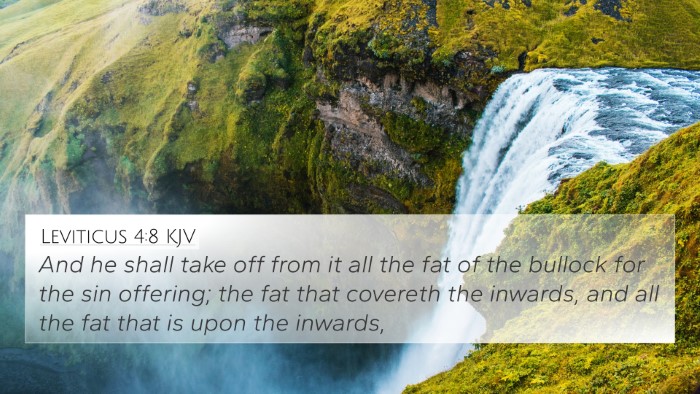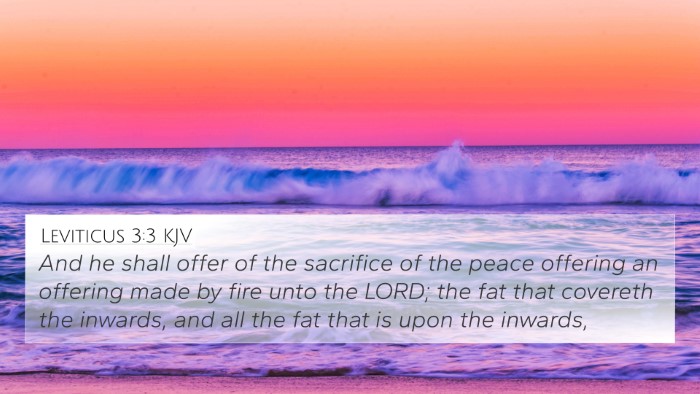Meaning and Explanation of Leviticus 8:16
Leviticus 8:16 states: “And he took all the fat that was upon the inwards, and the caul above the liver, and the two kidneys, and their fat, and Moses burned it upon the altar.” This verse details part of the ritual of consecration for Aaron and his sons as priests, specifically focusing on the offerings made and the specific parts of the animals that were designated for sacrifice.
Summary of Key Points
- Ritual Significance: The burning of the fat highlights the importance of these parts in sacrificial worship, symbolizing the offering of the best to God.
- Covenant Relationship: The act represents the covenant relationship between God and His people, emphasizing the need for purity and holiness in their service.
- Foreshadowing: The sacrifices foreshadow Christ's ultimate sacrifice, making it a significant connecting point in Scripture.
Insights from Public Domain Commentaries
Matthew Henry: He emphasizes that the fat and innards given to God reflect the desire to separate the devoted portion for divine service, symbolizing purity and dedication. The fat is seen as the choicest part of the offering, representing the best that worshippers can bring to God.
Albert Barnes: Barnes elaborates on the significance of sacrificial offerings in the context of atonement and communion with God. He notes that in the offerings, there is a representation of the entire people bringing their sins and gratitude before God. The portions burned on the altar were an offering of satisfaction to God, indicating that what was burnt was a sweet savor unto the Lord.
Adam Clarke: Clarke points out that this process and the specific parts chosen emphasize the holiness expected from the priests. He relates it to the cleanliness required in approaching God and the necessity for the priests' personal sanctification before they could intercede on behalf of the people.
Cross-References for Leviticus 8:16
- Leviticus 3:16-17: Discusses the fat being a part of the peace offerings that are to be given to God.
- Hebrews 9:22: Indicates that without the shedding of blood, there is no forgiveness of sins—a direct link to the significance of the sacrifices.
- Exodus 29:22: Details the offerings made during the consecration of the priests, further stressing the ritual's importance.
- Romans 12:1: Paul calls believers to offer their bodies as living sacrifices, suggesting a parallel in the dedication represented by the offerings.
- Leviticus 4:35: Shares the process of burning the sacrifice for sin, indicating the thoroughness expected in atonement.
- 2 Corinthians 2:15: Speaks of believers being the aroma of Christ, further drawing a parallel between sacrifices and the pleasing offerings to God.
- 1 Peter 2:9: Relates to believers as a royal priesthood, illustrating the ongoing sacrificial paradigm in the life of the believer.
Thematic Bible Verse Connections
The ritual described in Leviticus 8:16 is deeply rooted in the overarching theme of holiness and the requirement for sacrifices in maintaining the covenantal relationship with God. This theme continues throughout Scripture, linking to New Testament teachings such as:
- John 1:29: The declaration of Jesus as the Lamb of God who takes away the sin of the world.
- Hebrews 10:12: Where Christ offers Himself as the perfect sacrifice, fulfilling and superseding the Old Testament sacrificial system.
- Acts 10:15: God declares all things clean, signifying a shift from the Old Covenant that Leviticus represents to the New Covenant through Christ.
Understanding Sacrificial System in Context
To fully grasp the significance of this verse and its ritual context, it is essential to engage in cross-referencing Scripture. Tools for Bible cross-referencing such as a Bible concordance can help locate other relevant passages that provide deeper insights into sacrificial practices, the nature of holiness, and themes of atonement and divine acceptance.
How to Use Bible Cross-References
Understanding Bible verse parallels and connections between Bible verses can enhance one’s study. Here are steps on how to engage with cross-references effectively:
- Identify Themes: Look for thematic connections like sacrifice, holiness, and priesthood.
- Analyze Context: Understand the context of the passages you are comparing to see how they complement one another.
- Seek Guidance: Use tools like a cross-reference Bible study guide to find related verses.
- Reflect and Apply: Consider how these verses relate to personal faith and understanding of God's covenant.
Concluding Thoughts
In conclusion, Leviticus 8:16 offers profound insights into the sacrificial system of the Old Testament and serves as a foreshadowing of the ultimate sacrifice of Jesus Christ. Engaging with cross-references not only enriches one's understanding but also deepens one’s appreciation of the continuity of God's plan throughout Scripture.
